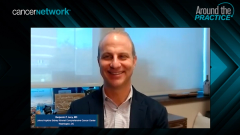
Patient Profile 1: Stage IIB NSCLC With High PD-L1 Expression
Shared insight on a patient profile of newly diagnosed non–small cell lung cancer with high PD-L1 expression and no driver mutation.
Episodes in this series

Transcript:
Charu Aggarwal, MD, MPH: With that, we’ll move to our first case. I’ll go through it and would love to hear some impressions about this case. This is a 66-year-old woman who presented after a referral from her local hospital with a cough and wheeze that was not responsive to beta-agonists. Definitely a former smoker, with 20 pack a year smoking history. She quit 8 years ago, very active, hikes regularly, ECOG performance status is 0, and lab testing was within normal limits. A CT [computed tomography] scan showed a left upper lobe lung mass, which was about five and a half centimeters. A PET [positron emission tomography] CT was performed, which confirmed uptake in this mass with no uptake in the mediastinum. A bronch EBUS [endobronchial ultrasound] biopsy of the lymph nodes was performed. That was negative for staging, and the brain MRI was negative. EBUS guided biopsy of the left upper lobe lung mass proved adenocarcinoma of the lung, and she was subsequently staged as stage 2B. Biomarker testing for EGFR [epidermal growth factor receptor], ALK [anaplastic lymphoma kinase], BRAF, and ROS [reactive oxygen species] were negative, and PDL1 expression was 70%. Harvey, I’ll start with you. Is there a typical paradigm for the management of such a patient who’s presenting with early-stage lung cancer? Do you send everyone to IPAN for initial bronchoscopy, or do you perform mediastinal staging with the mediastinoscopy? What’s your usual approach?
Harvey I. Pass, MD: In a case like this, independent of the PET scan being negative for 5.5-cm lesion, I believe that you need to have some sort of biopsy beforehand. We will send a patient like this to get interventional EBUS, either robotically or not just try to do what we can to know what the stage is before we enter. A 5.5 is a pretty big lesion in my opinion. I’ve always been concerned about those. We all know that lesions that are like that just are different from “other clinical stage 1 lesions.” They need to be worked up completely. It’d be nice to know what the real histopathology is, but we’re not quite good enough on a biopsy for 100% to say this is micropapillary, or this is a solid, but we can get some hints sometimes.
Charu Aggarwal, MD, MPH: Ben and Heather, is this somebody you would usually see in clinic or is this somebody who is predominantly managed on the surgical and IPAN [intrinsic primary] side. When do you get involved?
Heather Wakelee, MD, FASCO: We also have a very active multidisciplinary tumor board. It’s been on Tuesdays at 2 [pm] for at least 30 years now. It’s our time when all of our surgeons,and med-oncs and rad-oncs, pathology, and radiology, we all come together to talk about any cases we bring forward. Usually, we’re running through like 20 cases, and even sometimes have patients who come and be seen afterward, but this is a sort of case where we would probably talk about it a little bit. Just because it’s someone where the tumor’s big enough, there might be some interest in a neoadjuvant approach. There absolutely are patients with smaller stage 1s where the surgeons see the patient and just go straight to surgery and very appropriately. But any stage 3 patient, we have an unwritten rule that they’ll be presented. In this case with a larger primary tumor, we would talk about that. I wouldn’t formally have seen the patient. The surgeon would’ve seen the patient and then presented.
Charu Aggarwal, MD, MPH: Similar to what Harvey was saying. Ben?
Benjamin P. Levy, MD: Very similar for us. Our tumor board has been Wednesday morning at 8:30, I think since I’ve been here for the past 7 years. It used to be the potential surgical resectable 3As that were presented, but now with some competing strategies between neoadjuvant chemo-IO versus adjuvant chemo followed by IO, these cases are more commonly presented by the surgeon. But they’re generally seen by the surgeon first. And there has been more communication at our institution between the surgeons and the med-oncs and the rad-oncs. Obviously, this is a pitch for a multidisciplinary tumor board. We’ve all said it, and really, it does take a collective decision for some of these patients.
Transcript edited for clarity.
Newsletter
Stay up to date on recent advances in the multidisciplinary approach to cancer.























































































